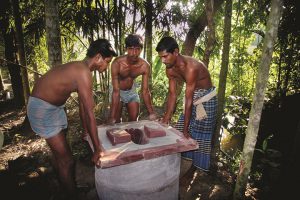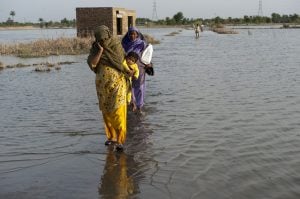Scarcities due to climate change impacts will necessitate a focus on “more for less”, and this makes it imperative to redress the current system of incentives and subsidies, says the latest edition of India’s annual economic survey.
The current subsidy system “Encourages using more inputs such as fertiliser, water and power, to the detriment of soil quality, health and the environment. They also disproportionately benefit rich and large farmers,” says the survey that was tabled in parliament on February 26, in preparation for the country’s annual Budget that will be presented on February 29.
Indian agriculture, is in a way, a victim of its own past success — especially the green revolution, says the survey in an unusually candid manner. “It has become cereal-centric and as a result, regionally-biased and input-intensive (land, water, and fertiliser). Rapid industrialisation and climate change are raising the scarcity value of land and water, respectively.”
The government says, “Agriculture requires a new paradigm with the following components: increasing productivity by getting ‘more from less’ especially in relation to water via micro irrigation; prioritising the cultivation of less water-intensive crops, especially pulses and oil-seeds, supported by a favourable Minimum Support Price (MSP) regime that incorporates the full social benefits of producing such crops and backed by a strengthened procurement system; and re-invigorating agricultural research and extension in these crops.”
Little water, inefficient use
Although water is one of India’s most scarce natural resources, farmers use two to four times more water to produce a unit of major food crop than in China or Brazil. “Hence, it is imperative that the country focuses on improving the efficiency of water use in agriculture,” the survey says.
India has invested enormous sums in irrigation canals and pumping up groundwater. Always, the water has been used in “flood” irrigation form. The government has now said, “Irrigation investments must shift to adopting technologies like sprinkler and drip irrigation and rainwater harvesting.”
Giving a peep into a possible move in the country’s Budget, the survey says more efficient irrigation technologies need to be accorded that “infrastructure lending” status that is currently accorded to canal irrigation. In effect, this will mean easier and cheaper credit for farmers to buy sprinklers and drip irrigation pipes.
Perverse subsidy
Most state governments provide free electricity to farmers. The government has once again acknowledged that this “incentivises wasteful use of water and hastens the decline of water tables.”
The survey gives numbers: the US National Aeronautics and Space Administration (NASA) has said India’s water tables are declining at a rate of 0.3 metres per year. Between 2002 and 2008, the country consumed more than 109 cubic kilometres of groundwater, double the capacity of India’s largest surface water reservoir, the Upper Wainganga.
Despite saying all this, the survey is silent about asking farmers to pay for electricity. That is a political hot potato no government is willing to touch.
See Electricity subsidies for poor are stolen by the rich
Rajveer Singh Yadav, a farmer in Gurgaon district of Haryana — close to New Delhi — told thethirdpole.net, “We don’t have to pay for electricity, but then there’s no electricity most of the time anyway. And no one knows when the lights will come on. So all of us keep our (irrigation) pumps switched on all the time. Yes, we often wake up to find our farms flooded. But what else can we do?”
Exporting water
The government has also admitted that India, a water scarce country, has been “exporting water” as a result of distorted incentives. This is different from water used in production, which is much higher. In 2010, India exported about 25 cu km of water embedded in its agricultural exports. This is equivalent to the demand of nearly 13 million people, says the survey.
India was a “net importer” of water until around 1980s. With increases in food grain exports, India has now become a net exporter of water — about 1% of total available water every year. The ratio of export to import of such virtual water is about four for India and 0.1 for China. Thus China remains a net importer of water. This is also evident in China and India’s trade patterns. China imports water-intensive soybeans, cotton, meat and cereal grains, while exporting vegetables, fruits and processed food. India, on the other hand, exports water-intensive rice, cotton, sugar and soybean.
Micro irrigation
Showing support for micro irrigation, the survey points out that an efficient drip irrigation system also enables optimal fertiliser use. It says the key bottlenecks in the adoption of this technology are high initial cost of purchase and the skill required for maintenance. “However, the increase in yields and reduction in costs of power and fertiliser use can help farmers recover the fixed cost quickly. Provisions for credit to farmers can incentivise greater adoption of this technology.”
The agriculture ministry started a drip irrigation scheme in 64 districts and found it was possible to use less water, less fertiliser and still have an increase in crop yield — up to 45% in wheat, 20% in gram and 40% in soybean. For a few months now, the government has been trying to popularise a slogan: “more crop per drop”.

In 2012-13, 33.9% of India’s cropped area was irrigated. The survey says the total Ultimate Irrigation Potential of India is about 140 million hectares. It also points out that there is substantial gap between Irrigation Potential Created (IPC) and the Irrigation Potential Utilized (IPU), and there is a perceptible decline in the ratio of IPU to IPC due to lack of proper operation and maintenance, incomplete distribution system, non-completion of command area development, changes in cropping pattern and diversion of irrigated land for other purposes.
Water productivity
Water productivity at the all India level is very low and needs to be enhanced through tapping, harvesting and recycling water, efficient on-farm water management practices, micro irrigation, use of waste water and resource conservation technologies. The overall irrigation efficiency of the major and medium irrigation projects in India is estimated at around 38%, says the survey, adding that efficiency of the surface irrigation system can be improved from 35-40% to around 60% and that of groundwater from 65-70% to 75%.
With experts in his own ministry making such a strong case to promote water use efficiency, it remains to be seen what steps the Finance Minister takes in this regard when he presents the Budget.






![A one-horned rhino in the grasslands of Orang (left) and a tiger in its wetlands [Images by Forest Department, Government of Assam]](https://dialogue.earth/content/uploads/2016/03/Orang_Wildlife_Image_Forest_Department_Assam-300x98.jpg)


